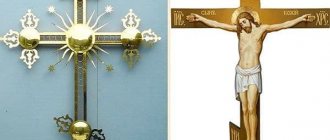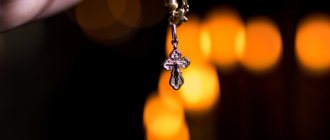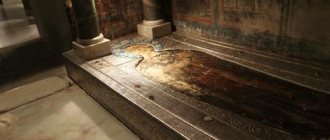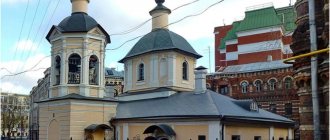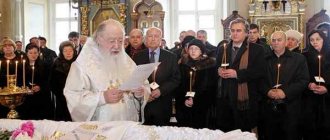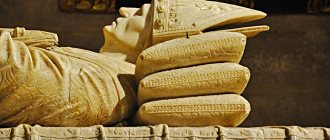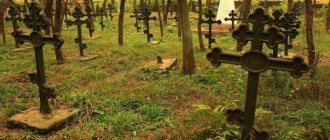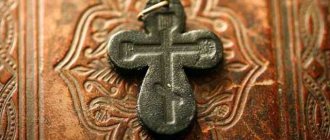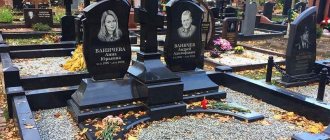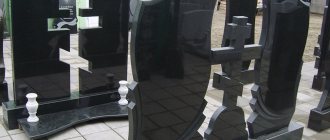Content:
- Why is a cross placed on graves?
- Where should you put the cross?
- At my feet
- At the head
- What kind of crosses are placed on the grave?
- How is a monument installed?
- Funeral arrangements from the Honest Agent service
When organizing a funeral, it is important not only to conduct the funeral ceremony correctly, but also to figure out where the cross is placed on the graves of Orthodox Christians. Most people in our country are sensitive to religious traditions, so such issues should be approached with special attention. In Orthodoxy, the deceased are buried facing east, and a cross is placed at their feet. It is believed that in this way a deceased Christian will see the crucifix against the backdrop of the rising sun and pray to the Almighty. What does this custom symbolize? Why is a cross placed at the feet and in what cases can it be placed in the head of a deceased person?
For ancient people, the cross is a symbol of the sun and God
The cross became established in astrology during the Neolithic era. He was depicted in the center of a circle, which served to symbolize the sun.
We don't need to be afraid of astrology. Orthodoxy actively criticizes various newspaper fortune tellers and charlatans who publish “star forecasts for the coming week.” But ancient astrology and astronomy are a completely different science.
Then there was no gap between religion and the study of the sky, everything was connected, and every person understood that the stars are a projection of divine energy into our world.
The solar cross - since ancient times, this symbol has been revered by people in different variations. It lies at the heart of the Christian cross. Photo: upload.wikimedia.org
Accordingly, they monitored the sky, made forecasts based on observations, calculated calendars, set dates for holidays, and oriented crops based on the celestial bodies. And the survival of a person who began to master agriculture depended on this.
The sun is a giver of warmth and light and an expression of God’s care, which means that through it you can direct your gratitude to the Almighty. So it makes sense to talk not about the cult of the sun, but the sun as a connecting element of the earthly and divine. The cross is a symbol, a place of fusion of matter and spirit, a door to the other world.
Today's astronomers have established this symbol for the earth, but we know that initially everything was not so.
Why is a cross placed on graves?
The custom of marking a burial site with a grave mound dates back to pre-Christian times. The Orthodox Church adopted this tradition and supplemented it with its own canons, including the installation of a crucifix. It is generally accepted that throughout life each person carries his own cross, which already at the moment of existence takes on the image of the Sign of the Cross. A cross on a grave after death indicates that a true Christian rests here. His whole life was aimed at fulfilling the mission for which he was born, namely, serving the Lord and his son Jesus Christ.
Orthodoxy in Rus' is closely connected with the name of St. Andrew the First-Called. The Apostle is known for the fact that when confessing the Gospel he installed crosses, which in those days were made of wood. Today, when erecting crucifixes, the Christian Church follows the example of the apostle. The cross in Orthodoxy is considered the silent righteous saint of resurrection and immortality, which symbolizes eternal life and the faith of the soul of the deceased in heaven.
When installing the cross, the relatives of the deceased fulfill one of God's commandments - love your neighbor. It often happens that, being near death, a person does not have time to undergo the sacrament of repentance, come to terms with something, or ask someone for forgiveness. When erecting a crucifix at the burial site, relatives seem to reconcile the deceased with this, since the Lord is love, and the Cross is a symbol of Jesus Christ.
Armenian funeral
Armenians hold commemoration immediately after the funeral and on the second day. As soon as the burial ceremony ends, everyone present is asked to perform ritual hand washing and is provided with water and towels. After this, everyone moves on to the funeral dinner. Kurkut (wheat cereal with beef), boiled beans and khashlama (stewed potatoes with pork) must be placed on the table. Dishes are usually prepared by distant relatives, since the hostess is considered “unclean” for the duration of the burial. At the table they read prayers for peace and drink wine for the bright path of the soul. Those present share memories of the deceased and say comforting words.
According to one tradition, it is customary to “feed” the deceased, both before and after burial. On the first day of death, a piece of bread is placed on his chest, and after burial they come to the cemetery with food and drinks. The custom of coming to the grave on the second day is called “eknakhoh”. Those who come remember the deceased, drink and have a snack, and then pour some of the alcohol on the grave and place the food they brought there.
As in Russian customs, it is customary for Armenians to remember the dead on the 9th and 40th day of death. Funerals are also held on anniversaries and five great Christian holidays, including Christmas and Easter. In some regions of Armenia it is customary to keep mourning until the 40th day. During this time, women wear black dresses and men do not shave.
At my feet
The installation of a monument at the feet is not considered church law and rather refers to religious traditions, which are not obligatory to follow. However, in most cases it is placed at the foot of the bed so that the structure faces the face of the deceased. There are several interpretations of why Orthodox Christians do this:
- Thanks to this arrangement, the deceased can look at the cross through the rays of the rising sun and offer prayers to the Lord.
- In Orthodoxy, the crucifix is a symbol of eternity. It is believed that sooner or later the day of resurrection will come, and the risen dead will be the first to see the sacred symbol of the Sign of the Cross.
- There is a belief that after the resurrection, the crucifix will serve as a support for the dead, that is, when they get up, they will be able to lean on it.
- Many believers believe that before the Last Judgment, Jesus will appear to people from the eastern side, and the deceased will be the first to see him against the backdrop of the cross.
Be that as it may, the cross in the Orthodox religion is a source of light and faith, and the traditions of its installation are always honored and observed.
Types of crosses
Crosses, being pictorial symbols of persecuted Christianity, carried different shades of meaning hidden from the uninitiated, which is why there are so many varieties of them. Let's look at the most famous of them.
- The St. Anthony cross in the form of the Greek letter T depicted the crucifixion used for execution and became the basis for the appearance of the four-pointed cross, which appeared after the title of Christ was added on top. According to legend, Saint Anthony the Great wore Tau on his robe, hence the name of the symbol of faith;
- The life-giving cross is depicted as the Egyptian hieroglyph Ankh, meaning “life”;
- St. Andrew's cross in the form of the letter X of the Greek alphabet meant the very name of Christ in ancient writings. As the legend says, Apostle Andrew died on such a cross. It was this sign that Peter the Great placed on the coat of arms, hand seal and on the flag of the navy in order to clearly separate Orthodox Russia from Western heretics;
- The round bread cross originated from the Christian tradition of cutting baked bread lengthwise and crosswise before eating;
- The four-pointed “catacomb” cross personifies the sign shown in the sky by God in 312 to King Constantine. He contributed to the change in meaning from a shameful instrument of execution to a sign of victory and an object of veneration;
- The Russian “patriarchal” six-pointed cross with two crossbars, the top of which is short, was used on the seal of the governor of the Byzantine emperor in Korsun;
- A four-pointed cross in the shape of a crucifix with a crossbar at the top is one of the most common gravestone symbols in cemeteries. It came into widespread use in the Orthodox East from the 3rd century;
- A six-pointed Russian Orthodox cross with two crossbars, the lower of which is beveled from top to bottom in the direction from left to right - a symbol of the measure of righteousness for sinners. The bottom bar represents the hardship of Christ's blasphemy, which tips the bar of the scale down. The upper horizontal line is repentance, thanks to which they gain forgiveness and ascend to the Kingdom of Heaven;
- The eight-pointed Orthodox cross corresponds more closely than others to the shape of the crucifixion on which Christ was executed. It has a title and a foot;
- A cross with a crown of thorns in the middle symbolizes victory and reward;
- The shape of a trefoil cross is used to make altar symbols and state symbols, in coats of arms;
- The wicker cross came from Byzantium and was often used to decorate early printed books in Russia and Bulgaria;
- The drop-shaped four-pointed cross signifies the transfer of the power of Christ to the crucifixion through drops of his blood from the wounds;
- The crucifixion cross with the image of the crucified Christ appeared in the 5th century and since then began to be used in the manufacture of pectoral crosses.
At the head
The custom of placing a crucifix behind the head of the deceased is more often followed by Orthodox Christians who live in Western or Central Europe. In their opinion, this arrangement symbolizes the victory of the Son of God over the devil. At the moment of Judgment Day, the cross will become a banner for the deceased, which he will carry after his resurrection. It will indicate the triumph of good over dark forces and will serve as a weapon in the fight against Satan.
What kind of crosses are placed on the grave?
Immediately after the burial, it is customary to install a wooden crucifix, which should not have any frills or decorations. The material can be pine or beech. Special compounds are applied to the wood to prevent its premature deterioration under the influence of precipitation.
Since wood is not durable, after the earth settles, the wooden crucifix can be replaced with a metal, marble or granite one. Such products are distinguished by their impressive appearance and resistance to weather conditions. It is advisable to install them 12 months after burial. This is due not only to the sedimentation of the soil, but also to the belief that the soul of the deceased leaves the earth a year after death.
It is permissible to decorate a crucifix with ornaments or religious symbols. Most often used for these purposes:
- images of thorns or vines;
- abbreviations or inscriptions from the Bible;
- figures of Jesus Christ (superimposed or carved).
Depending on preferences, relatives can select the shape of the crucifix. The most ancient is considered to be the four-pointed one, which was used during the times of the early Christian church. Today it is rarely chosen and is usually used for burying people who did not identify themselves with any denomination.
The most common is the six-pointed shape. Such a monument looks like an ordinary cross, under which there is an oblique transverse crossbar. Sometimes an eight-pointed structure is used for burials. It is in many ways similar to the six-pointed one, but a shorter straight crossbar is additionally installed in its upper part.
Temporary wooden crucifixes, after the installation of a permanent monument, are burned directly in cemeteries or in church ovens. They should not be thrown away, as this indicates disrespect for the deceased. Often a wooden cross is left next to the grave or leaned against the fence. It is important that he does not lie on the grave mound.
Armenian beliefs and burial traditions
The Armenian people believe in fate (“tchakatagir”) and believe that the date of death is determined at birth. On the day of death, an angel comes to a person and takes away the soul, which is separated from the body immediately after the release of the spirit. There are beliefs that if a dying person does not want to leave at the time allotted for him, then an angel takes his soul by force. In such a situation, death is accompanied by death agony. So that the angel can leave with his soul without hindrance, in the room where the dying person lies, the doors and window sashes are opened wide.
After the repose, the news of his death immediately spreads throughout the area. All relatives and neighbors immediately go to the house of the deceased to say goodbye and express condolences to loved ones. If a person dies outside a populated area, there is a custom to climb to a hill or the roof of a building and shoot from a gun in order not only to notify of the death, but also to prevent a recurrence of misfortune in the family.
It is believed that the soul that has flown away from a person remains next to the deceased until his burial, so preparations for the funeral begin immediately after the repose. A clergyman is invited to the house. He must consecrate the water for washing the body and the shroud in which the deceased will be wrapped. Ablution is performed on a special board on which the body is laid facing east. In the place where the deceased was washed, a lamp or candlestick is lit, which should burn for a week. There is an opinion that in this way he illuminates the soul’s path to heaven.
Until the 19th century, the deceased were buried in a shroud. At night, the deceased was carried to the church and placed on a special funeral stretcher. If a child died, a candle was placed in his hands so that after the death of his parents it would light the way to heaven. Today, Armenians use traditional coffins, which are decorated in the same way as in Russian Orthodox traditions.
There are many known beliefs and funeral customs among the Armenians, which have been preserved since pagan times:
- After the death of a person, it is customary to cover the mirrors in the house and stop the clock.
- Until the body is taken out of the house, a lighted candle should stand next to it.
- A dead person is never left alone. One of his relatives, friends or neighbors should always be near him.
- Before the body is taken out, the coffin is wrapped around an axis three times. If there is not enough space in the room, it is simply lowered and raised three times.
- The grave is dug in such a way that the deceased lies with his feet to the east.
Armenians do not welcome haste. It is believed that fuss during a burial is disrespectful to the deceased.
How is a monument installed?
In accordance with church canons, a memorial structure is installed at the time of burial. For 40 days nothing can be done at the grave, since it is believed that after this time the deceased will go to Golgotha, carrying a crucifix. Then the wooden cross can be replaced with a permanent one, but, as mentioned above, it is better to wait up to 12 months. The right time to install a stone structure is from March to September. There is less rainfall at this time, so the ground does not erode as much.
Funeral arrangements from the Honest Agent service
If you don’t know where the cross is placed during burial, contact the “Honest Agent” ritual service for help. We are engaged in professional organization of funerals and provide a full range of services for conducting a funeral ceremony. Our specialists will provide detailed advice, help with preparations for burial and answer any questions regarding the observance of Orthodox traditions.
Our agency's competence includes the production and installation of grave monuments. You can order high-quality granite and marble crosses from us, as well as receive many additional services:
- design development;
- making portraits and engravings;
- insurance of grave structures;
- delivery and installation of the monument;
- grave care.
To order a funeral from professionals, contact us by phone. When you apply, you can count on a decent burial, which will be carried out in full accordance with the religious views of the deceased person.
Tell your friends:
Day of death
After death, the deceased is washed, dressed and placed in a coffin so that his head faces west and his feet face east. The house cover is not brought into the house; it is left near the entrance doors. Things that were dear to his heart are placed next to the deceased. During burial, they are lowered into the grave so that nothing holds the deceased in this world.
Before the funeral, the deceased is visited by relatives and friends. It is customary for Armenians to provide financial assistance to the relatives of the deceased, so in the room with the coffin they place a box where visitors can put money. If one of the people owes money to the deceased, he is obliged to repay the debt, and if this is not possible, the relatives must be informed about it.
